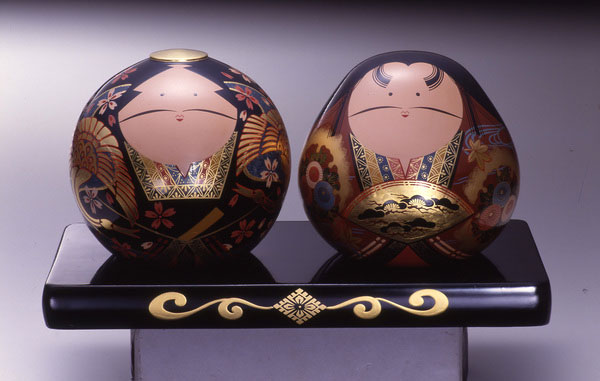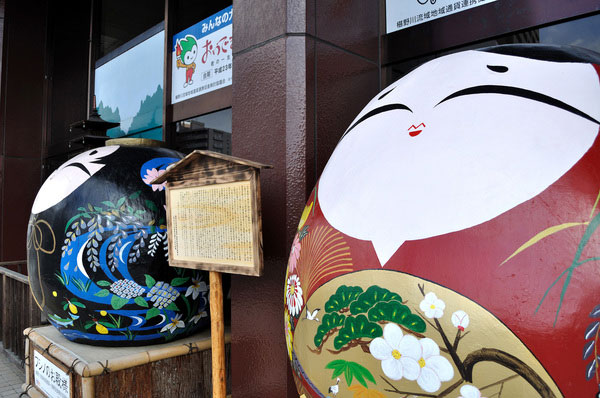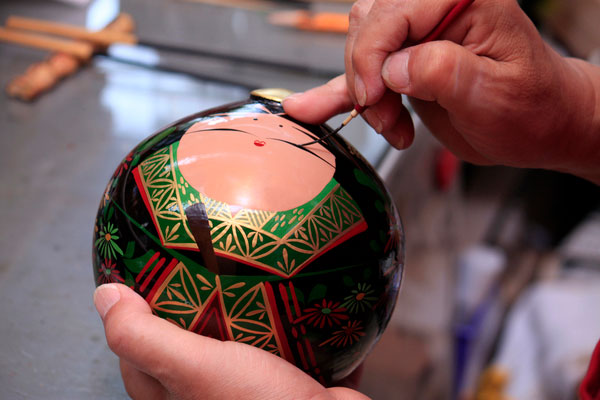
- Lacquerware
- Yamaguchi
Ouchi lacquerware Ouchi nuri
A great variety of different articles
Autumn flower patterns drawn with colored lacquer
Description
What is Ouchi lacquerware ?
Ouchi lacquerware (called Ouchi nuri in Japanese) is produced around the city of Yamaguchi, in Yamaguchi prefecture. This craft emerged under the Ouchi clan, which boasted significant influence and power in the region during the Muromachi period (1336-1573).
This lacquerware is decorated with elegant patterns of autumn flowers, like bush clovers and Japanese pampas grass. Colored lacquer is used to draw on a deep, austere vermilion base and gold leaf in the diamond shape of the Ouchi family crest is applied. As Ouchi lacquerware is coated with many layers of lacquer, it is durable and resistant to fading.
Apart from bowls and trays, Ouchi dolls are particularly famous and are popular as souvenirs. The story behind the design of these dolls is that Hiroyo OUCHI, the ninth head of the clan, had doll makers move to Yamaguchi from Kyoto and produce dolls for his residence in order to comfort his wife who was homesick for Kyoto. These dolls have round faces, almond-shaped eyed, and puckered lips, and are always in a pair. They are widely loved as a symbol of matrimonial happiness.
History

This craft is said to have started in the late 14th century when the Ouchi clan invited lacquer craftsmen from Kyoto to produce lacquerware in Yamaguchi. The Ouchi clan, took up residence in Yamaguchi, modelled city building after Kyoto because of their admiration, and promoted cultural development and trade with China and Korea. As a result, a unique culture named Ouchi culture, which was a blend of Kyoto, Chinese and Korean cultures, arose in Yamaguchi. The production of Ouchi lacquerware flourished during this time and become one of the most important exports to China and Korea.
Unfortunately, due to the trade with China and Korea ending after the destruction of the Ouchi clan and the successive clan moving to a different city during the Edo period (1603-1868), the production of quality lacquerware ended. However, the discovery of Ouchi-wan, a set of luxurious lacquer bowls from the Ouchi era, among the Mori clan’s collection during the Meiji period (1868-1912) sparked the revival of the craft, with the bowls used as reference. Also, the term Ouchi-nuri started being used during this time. The first Ouchi dolls were created at the Yamaguchi Prefectural Industrial Technology Institute during the Taisho period (1912-1926), and became an integral part of the craft.
General Production Process
 Photo:Yamaguchi Prefectural Tourism Federation
Photo:Yamaguchi Prefectural Tourism Federation
- 1. Wood base
Trees are cut down and slowly dried naturally over a few years. The pieces of wood that are well-dried and suitable for the intended work are selected. Wood from Japanese snowbell, Japanese zelkova and Japanese horse-chestnut trees are used for bowls, round trays and dolls, while wood from Japanese cypress, empress and Japanese big leaf magnolia trees are used for bento lunchboxes and inkstone boxes, which require parts to be joined together.
- 2. Base preparations
The completed wood base is checked for any scratches or insufficiently bonded joints. The surface has to be smooth in order for lacquer to be coated evenly. Any scratches must be smoothed by applying a mixture of raw lacquer, sawdust and rice glue. As the base and edges of the bowl are fragile, they are strengthened with adhesive lacquer, washi (traditional Japanese paper), and cloth. The surface of the wood base is evened out and base lacquer (a mixture of raw lacquer, polishing powder and diatomaceous earth powder) is applied using a brush or spatula. Then the piece is dried and wet sanded with waterproof sandpaper and whetstones. Wet sanding is the process of wetting and polishing objects.
- 3. Undercoating
The base is undercoated with lacquer and dried. Then, the undercoat is wet sanded with waterproof sandpaper and a special charcoal used for lacquer polishing.
- 4. Middle coating
A middle coat is applied over the polished undercoat and dried. Then, the middle coat is wet sanded using charcoal and waterproof sandpaper.
- 5. Overcoating A lacquer overcoat is applied over the middle coat. The lacquer used for overcoating is filtered with traditional Japanese paper to remove dust and dirt, before being carefully applied onto the wood base in a dust-free overcoating room. The piece is then placed inside a muro or drying cabinet where the temperature and humidity are carefully regulated, and slowly dried for twelve to twenty four hours. Lacquer reacts with the absorbed oxygen and moisture and changes from a liquid to solid state.
- 6. Decoration
The piece is now decorated with designs. Common decorations include urushi-e, where pictures are drawn using colored lacquer, haku-e, where gold and silver leaf is pasted to form patterns, and maki-e, where gold and silver dust is sprinkled onto patterns drawn with lacquer. Each piece takes about a month or two to complete as these processes are done by hand.
Where to Buy & More Information
The Yamaguchi Furusato Heritage Center
-
Address
-
Tel.+81-83-928-3333
-
ClosedAugust 14-16, December 29 - January 5
-
Business Hours9am to 5pm
-
Website
See more Lacquerware
- Wajima lacquerware
- Kamakura-bori lacquerware
- Tsugaru lacquerware
- Aizu lacquerware
- Yamanaka lacquerware
- Kawatsura lacquerware
- Echizen lacquerware
- Joboji lacquerware
- Kiso lacquerware
- Hidehira lacquerware
- Kagawa lacquerware
- Ryukyu lacquerware
- Takaoka lacquerware
- Wakasa lacquerware
- Hida-shunkei lacquerware
- Ouchi lacquerware
- Kanazawa lacquerware
- Kishu lacquerware
- Kyo laquerware
- Odawara lacquerware
- Naruko lacquerware
- Niigata lacquerware
- Murakami carved lacquerware































































































































































































































































































